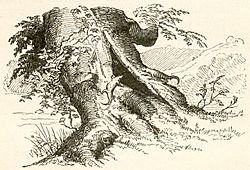The Elf Mound facts for kids
Quick facts for kids "The Elf Mound" |
|
|---|---|

Illustration by Vilhelm Pedersen, Andersen's first illustrator
|
|
| Author | Hans Christian Andersen |
| Original title | "Elverhøi" |
| Country | Denmark |
| Language | Danish |
| Genre(s) | Literary fairy tale |
| Published in | New Fairy Tales. First Volume. Third Collection (Nye Eventyr. Første Bind. Tredie Samling) |
| Publication type | Fairy tale collection |
| Publisher | C.A. Reitzel |
| Media type | |
| Publication date | 7 April 1845 |
| Followed by | "The Red Shoes" |
"The Elf Mound" (called Elverhøj in Danish) is a magical fairy tale written by the famous Danish author Hans Christian Andersen. He lived from 1805 to 1875. This story is all about a big party happening inside an elf mound. The party is for the Goblin Chief of Norway and his two sons. Everyone expects the sons to pick their elf brides at this special event. The tale was first published in Copenhagen, Denmark, in April 1845.
Contents
What Happens in The Elf Mound?
Two little lizards are busy near the entrance of the Elf Mound. They are chatting about all the excitement inside! They've heard the elf maidens are practicing new dances. Both lizards wonder why there's so much fuss.
An old maid elf rushes out of the mound. She calls a raven to help her deliver invitations for a very important event. Inside, the elf maidens begin their misty, graceful dances.
The Royal Feast Begins
The dishes for the night's big party sound quite unusual! There are skewered frogs, a fungus salad made from mushroom seeds, and even hemlock. The Elf King is busy polishing his crown. His youngest daughter is curious and asks him about the party.
The King explains that he has arranged marriages. Two of his daughters are going to marry two sons of the Goblin Chief of Norway. Just then, the Goblin Chief and his sons arrive with a lot of fanfare and noise.
Choosing the Brides
The feast begins, and the two Goblin sons are very loud and boisterous. They are not very polite! The elf maidens are then presented as possible brides. Each maiden shows off her best talents. The Goblin Chief is so pleased that he chooses one of the elf maidens to be his own wife.
As dawn approaches, the old maid elf wants to close the shutters. The two sons of the Goblin King hurry outside. They want to continue their silly games and horseplay. They leave without choosing any brides for themselves.
How The Elf Mound Inspired Others
This story has had a lasting impact on other works of art. The most famous example is the Norwegian stage play Peer Gynt. In that play, the Mountain King (called Dovregubben) is clearly based on the Norwegian troll king from Andersen's tale. It is believed that the famous writer Henrik Ibsen was inspired by Andersen's story when he wrote Peer Gynt.
Also, a Dutch composer named Johan Wagenaar wrote a piece of music. It's called the Elverhoi-ouverture Op. 48, and it was inspired by "The Elf Mound."

